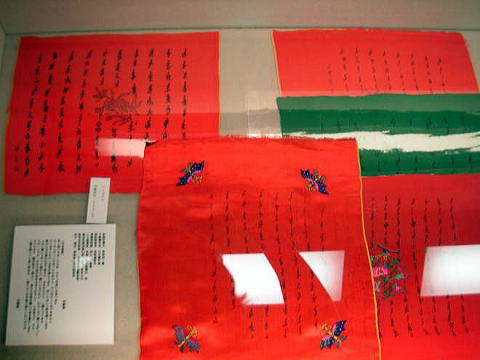
A Report on the Exhibition of Nushu Collection
In order to introduce the beauty and the value of Nushu, Chinese women’s script, we held the following exhibitions in Japan and the U.S.A. this year.
1. January 20 – 24, 2010
We held “The Exhibition of Chinese Cultural Heritage Women’s Script”
in the Shizuoka Citizen’s Gallery. We had about four hundred visitors in a total of five days. Ms.Kasei. Kinosita’s calligraphy warmed up the exhibition, too.

[At the Citizen Gallery of Shizuoka]
2. January 27 – February 28, 2010
We held an exhibition of the Nushu collection at the archive display corner in the front hall of the National Women’s Education Center in Tokyo. Visitors to the Hall for attending the seminar and so on watched the exhibition with interest.
3. March 26 – May 9, 2010
At Gallery éf in Asakusa, Tokyo, we held an exhibition titled “ Nushu:
the Linked Verses of Art and Science ” in collaboration with YUCA. We had about 4,000 visitors.
Some of their comments are as follows:
“I’ve never seen such beautiful letters, calligraphy and songs. I was profoundly impressed.”
“I came from Fukuoka City to look at Nushu. I could hear as if the women were speaking their hidden feelings in whispers. Seeing their works, I felt their crimson-colored tears.”
4. March 31 – April 2, 2010
At Colby College in Maine in the U.S.A., we held an exhibition of the Nushu collection and a lecture meeting titled “A Secret Women’s Script in Southern China”.
Professors and students of the college showed great interest in Nushu as a product of women’s culture. Some of their comments are as follows:
“What a beautiful and fascinating exhibition! Thank you for showing us your collection to us“.
“Thank you, Professor Endo for your research on Nushu! Your work helped us to appreciate these women’s lives and their sufferings”.
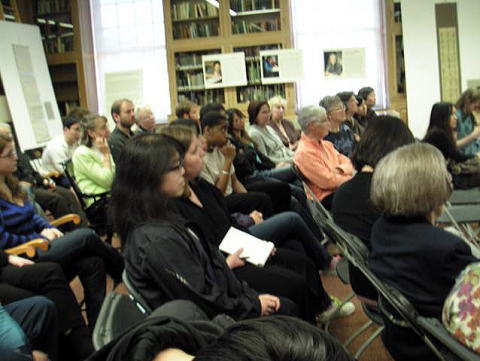
[The Audience of the presentation at Colby College ]
5. April 4 – 6, 2020
We held an exhibition of the Nushu collection and a panel discussion at Smith College in Massachusetts, in the U.S.A. The title of the panel discussion was “Gender, Language and Culture in East Asia -Past and Present-“.
I made a presentation titled “The Creative Power of Women’s Writing in the East Asia”. The audience asked such questions as “Are there any transmitters of Nushu at present?”, “Are the songs sung in standard Chinese?”, “Did Chinese men know about Nushu?” and so on.
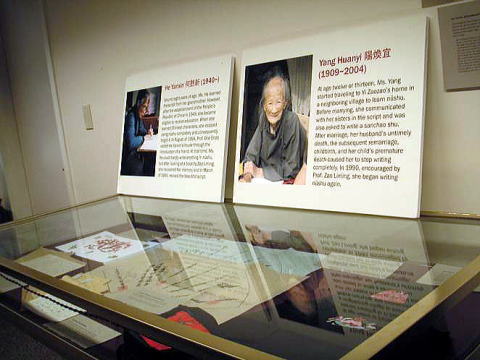
[The Show case and panel at Smith College]
6. April 8 – 11, 2010
In Maryland in the U.S.A., we held an exhibition of the Nushu collection. Some students were eagerly copying the explanations written on the panel. Some of their comments are as follows:
“So fascinating! I wish it wasn’t going extinct”
“I loved that sworn sisters had a bond strong enough to create a whole new language—just to keep some intimacy between sisters that were separated. Really great stuff to learn about”.
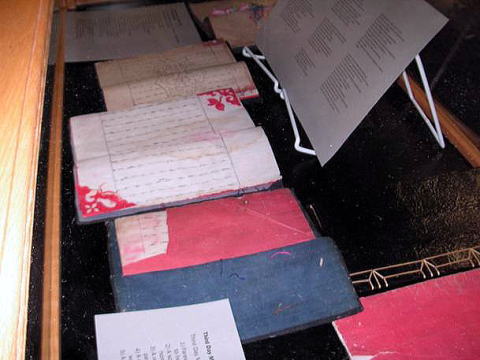
[The show case at Mary Land University]
A Report on the Symposium on the Safeguarding of “the Folkways of Nushu (女書習俗)”
The Symposium on the Safeguarding of “the Folkways of Nushu, Chinese Women’s Script (女書習俗)”, was held at Hotel Kun Lun (崑崙飯店) in Beijing on August 28, 2010. As I joined the symposium, I would like to report on the symposium and the present situation of Ms. He Yanxin (何艶新) as follows:
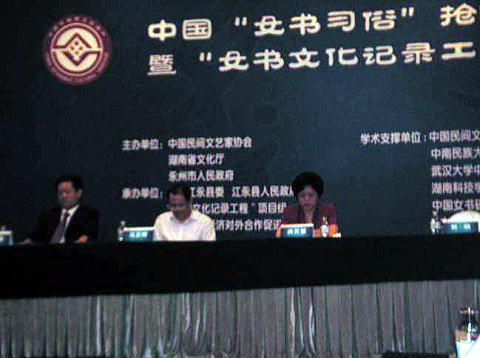
[Opening Ceremony of the Symposium ]
The Jiangyong Prefectural Government, Yongzhow City, Hunan Province (湖南省永州市江永県) is attempting to apply Nushu (女書) for World Cultural Heritage status as nonmaterial cultural heritage. For that purpose, the symposium was held by inviting scholars and researchers of the World Heritage Recommendation Committee to encourage them to appreciate the value of Nushu. On that day, various events were held such as introducing Nushu, a demonstration by transmitters, performing songs and dances, presenting researchers’ reports on Nushu, and finally, comments by the judges.
In the morning, for the exhibition of the original works of Nushu folkways, there were demonstrations by transmitters, displays of Nushu materials showing Nushu and Nuhon(女紅)works on slides. There were three copies of Sanchao Shu(三朝書) fastened to the walls with tape.
For the demonstration of Nushu, six transmitters, including He Yanxin (何艶新), He Jinghua (何静華) and Hu Meiyue (胡美月), stood in line on the stage, and each of them wrote some Nushu script in large letters with a writing brush on an oblong piece of paper more than one meter long. They then held the paper up with their hands and showed the script they wrote. This was only for showing how to write the Nushu script. In truth, Nushu script is never written with a brush.
Such a large script of 15-20cm in size was never found in the original Nushu materials. Since Nushu was a means to communicate privately, it was not necessary to write large script. Small and well-formed letters written in thin lines were regarded as beautiful.
Next, the six transmitters separated into groups of three on the left and right sides, and started to sing in turn. Later, Ms. He Yanxin told me that they were forced to sing the songs written by He Jinghua. Subsequently, the dances they danced were created by He Jinghua, too. They started practicing dancing this spring, which I heard from Ms. Liu (劉). On this occasion, they were able to show the fruits of their efforts.
As Nushu was used for writing songs, it was closely related with song, but no relation with dancing is found within Nushu materials, nor is there any description of sworn sisters dancing together. When I visited the Nushu Cultural Village in 2004, Ms. Pu Lijuan (蒲麗娟), Ms. He Jinghua’s daughter, showed me the dancing of ancient women who were doing nuhong (女紅), but the dancing was never related with Nushu.
In the afternoon, a meeting for research papers was held, where such papers titled as “The specific character of Nushu folkways and safeguarding them”, “To comment on the five models of transmission of Nushu”, “The peculiar fascination of Nushu” and so on were read. I myself read my paper titled “The value of Nushu seen from autobiographical works written in Nushu”. The gist of my paper was as follows: The autobiographies written in Nushu are exceptional as creative activities by common women, and from them we can see China’s modern history and the history of the sufferings of common people. It is because women created the precious script of Nushu that they could leave such autobiographies.
In conclusion, a specialist of the World Heritage recommendation committee and a specialist of the nation-level committee for safeguarding nonmaterial cultural heritages stated their opinions, the summary of which is as follows:
(1) “To keep the original form of Nushu” is key.
(2) It is improper to write a shrine name in Nushu, because Nushu was originally not used for public purposes.
(3) It will be tricky to determine what category in which to place Nushu cultures, such as marriage, festivals, and so on, for a world cultural heritage.
(4) The concept of culture and folkways is not clear.
(5) How are songs and dancing related to Nushu? If they exist without Nushu, they would have no relation to Nushu.
Most of these opinions were critical ones.
Previously, the prefectural government considered the transmission of Nushu as writing large letters with brushes and presenting newly made songs and dancing as ancient folkways, which are far from the original form of Nushu.
As the experts outspokenly stated their comments, the local government might have realized their mistake. In order to preserve the original form, they should focus their energy on collecting more original materials such as 三朝書.
The main points of an interview with Ms. He Yanxin (何艶新) on August 29, 2010 at Hotel Kunlun (崑崙飯店)
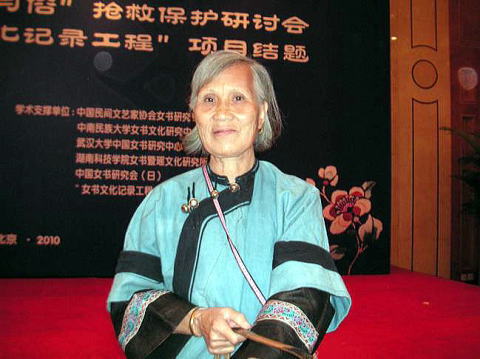
[Ms. HeYanxin at the Symposium]
She spoke as follows:
These days I am rather sickly, so I have not been writing Nushu much. At first, I received 20 yuan monthly as a transmitter from the prefectural government, but last year the amount was raised to 50 yuan and now I receive 100 yuan.
This April, the government applied for He Jinghua (何静華)and Hu Meiyue (胡美月)to become national transmitters, and He Jinghua will receive 3,000 yuan and Hu Meiyue 2,000 yuan respectively this year. I am not a transmitter anymore and therefore, my name was not put on the government list for the symposium at first, but Ms. Endo asked them to let me attend, so they added my name to the list.
To tell the truth, I did not want to write Nushu script on stage at the symposium yesterday. I learned how to write the script from my grandmother, but she did not write such large script. Writing the script with a brush was started by Zhou Shuoyi(周碩沂). As He Jinghua learned Nushu from him, she is liable to write with a brush. A government official told me to write in large script at Beijing, so I did so unwillingly. If I was disagreeable, I would hurt Ms. Endo’s reputation, so I wrote, but I am ashamed to say that I wrote such false script. Since other transmitters decided to go to Beijing much earlier than me, they had enough time to practice writing the script, but I had almost no time to practice. I was bad at writing.
They also practiced singing the songs. He Jinghua(何静華)knows nothing about getang (歌堂), so she asked me about it. Now she is teaching singing as a teacher. The government officials tells her to do just that.
The female assistant general manager Xiao (肖) said to me, “You are not a transmitter, because you are not bringing up young people for transmission”.
I like teaching how to write Nushu script, and now I am teaching my 30-year-old daughter. She can write the script. If a place for teaching Nushu were available, I would like to teach. If they build a school at Heyuan Cun(河淵村)where I live, I will teach there without pay. Without even setting up such a place, Xiao says to me that I am not raising others to be successors. This is only her excuse.
He Jinghua lives in a town and sells herself well, so it is convenient for Xiao to rely on her.
I am living in an inconvenient country side, so I have few visitors.